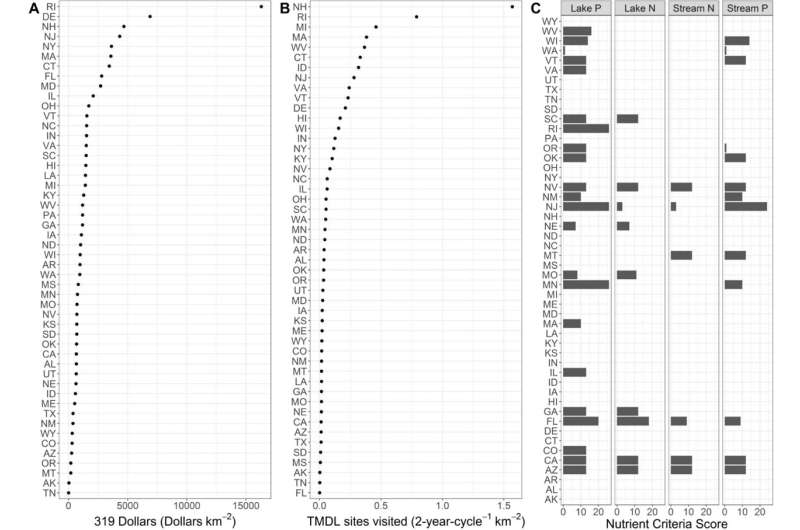This article has been reviewed according to Science X's editorial process and policies. Editors have highlighted the following attributes while ensuring the content's credibility:
fact-checked
peer-reviewed publication
trusted source
proofread
Parts of Clean Water Act not effective in controlling nutrient pollution, research suggests

When rivers began catching on fire, the U.S. government knew it was time to act. So Congress passed the Clean Water Act of 1972.
It remains the guiding legislation for regulating America's water quality. But new research from the University of Georgia, published in Ambio, suggests parts of it may not be working.
The study found that Clean Water Act regulations haven't significantly reduced the amount of nonpoint source nutrient pollution in America's waterways.
Nonpoint source pollution is a catchall term for contamination that isn't discharged from a pipe.
It's a major type of water pollution and includes things like fertilizer and insecticide runoff from agricultural fields or residential areas, bacteria from pet waste and livestock lots, and chemicals and oil from urban areas.
Rain or snow washes away the contaminants, taking them to waterways and allowing them to penetrate the soil and potentially seep into groundwater. That makes it a particularly difficult type of pollution to contain.
The researchers analyzed 10 years of data from the National Rivers and Streams Assessment and the National Lakes Assessment to determine changes in nutrient concentrations. They found that the current federal policy is not doing what it set out to do.
"The Clean Water Act set incredibly ambitious goals for water quality improvement in the United States," said Laura Naslund, co-author of the study and a doctoral student in UGA's Odum School of Ecology. "It said that we want all streams and rivers, all waters of the U.S. to be fishable, drinkable and swimmable in a little over a decade. We have failed to meet those goals."
Clean Water Act successful at reducing pollution from point sources
The Clean Water Act has been massively successful at reducing pollution from specific sources.
For example, before the Clean Water Act, counties were dumping raw human waste into waterways with impunity. The passage of the act stopped that and implemented wastewater treatment protocols that have greatly reduced sewage pollution.
But it's been far less effective at managing nutrient levels from nonpoint source pollution that can make water unusable and undrinkable, said Nathan Tomczyk, corresponding author of the study and a recent doctoral graduate from UGA's Odum School of Ecology.
Previous research has shown that roughly half of America's bodies of water are impaired by excess nutrients, much of which comes from nonpoint source pollution.
The present study looked specifically at concentrations of dissolved nitrates, like what is commonly used in fertilizers; dissolved ammonium; and total nitrogen and phosphorus levels in streams, rivers, lakes and reservoirs throughout the U.S. Nitrogen and phosphorus are two of the leading causes of water impairment in the U.S., leading to algae blooms and decreased oxygen levels that harm fish and other aquatic life.
The researchers found that average nutrient concentrations increased in waterbodies in 29% of states over the decade they studied. While some states did show decreases in nutrient concentration, further analysis showed that decrease was attributable to one specific nutrient in most cases and did not correspond to a decrease in all nutrients.
About half of the states maintained the same average nutrient concentrations in their waterbodies over the study period.
EPA restricted in regulatory power by Clean Water Act
While the study found current policies aren't having an impact at the state level, the researchers caution against blaming the federal agency for continuing water quality issues.
Under the legislation, the EPA delegates much of the implementation and enforcement of the Clean Water Act to the states. By comparison, the Clean Air Act is more specific on what policies and efforts states must implement to keep America's air quality pristine.
"I think we need to take a serious look at the way that nonpoint source pollution is regulated and the fact that it mostly relies on voluntary measures," Naslund said.
More information: Nathan Tomczyk et al, Nonpoint source pollution measures in the Clean Water Act have no detectable impact on decadal trends in nutrient concentrations in U.S. inland waters, Ambio (2023). DOI: 10.1007/s13280-023-01869-6
Journal information: AMBIO
Provided by University of Georgia



















